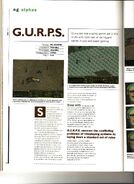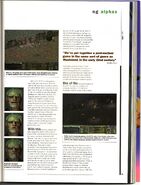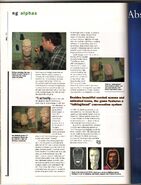| The following is based on developer commentary. |
The GURPS preview article is a three-page preview of Vault 13: A GURPS Post-Nuclear Adventure published in the June 1996 edition of Namco (NG) Community Magazine, featuring quotes from Tim Cain.
Transcript[]
Computer role-playing games get a shot in the arm from one of the biggest names in pen-and-paper gaming
Steve Jackson is no newcomer to either the pen-and-paper roleplaying market or to computer gaming. Back in the early 1980s, two of his most popular board games, Ogre and Car Wars were converted over to computer formats by the then-king of CRPGs, Richard Garriott, and his teams at Origin.
Shortly after, Jackson released what was to be the ultimate answer to roleplaying. Called G.U.R.P.S. (Generic Universal Role-Playing System), the new game was to answer all of the problems of conflicting roleplaying systems by laying down a standard set of rules that would work in any of the system's myriad universes. In this way, players could use the same basic rule book to create a cowboy, an alien, a martial artist, or a standard Tolkienesque adventurer, requiring only a few rules specific to their home realm to round them out. The fledgling system quickly gained popularity and soon there were a whole set of worlds for players to explore ranging from ice-locked prehistoric plains to the powerstacks of a cyberpunk future.
Even with the success of the new system and the stabilization of the PC as a CRPG platform, no plans for a computer release were announced. Then, in early '94, Interplay announced that it has acquired the G.U.R.P.S. license and was beginning work on a new set of RPGs. Before gaming had a chance to get too excited though, Interplay also managed to grab the rights for TSR's AD&D world out from under SSI, forcing many to wonder whether Interplay would continue work on the G.U.R.P.S. project. After a long silence, Interplay is now finally ready to show the details of its long development cycle, and while it remains to be seen how well everything will work in the end, the individual pieces have the potential to change the face of computer roleplaying forever.
Since G.U.R.P.S is designed to work with any time zone or fictional setting, the first thing developers had to do was to decide which universe the new game would be set in. In the end, it was a look for something new that led the development team to its decision. Tim Cain, the game's producer, explains: “We've put together a post-nuclear game in the same sort of genre as Wasteland, but of course, we're not a sequel to that game. It's set in the very early part of the 22nd century, just after a nuclear holocaust, and your character has been raised on one of the civil defense vaults that the population has been forced to inhabit. The basic storyline is that you have to leave the relative comfort of the vault to find a chip to repair the bunker's water purification unit.”
With this opening, players will get a chance to venture into a world that will be completely new to them. As the game continues, characters will discover that there is a great deal more to this quest than first meets the eye. Cain continues, “We plan to have a lot of subquests. They aren't really necessary in the sense that if you don't do them you can't finish the game, but they will be necessary in the sense that in order to finish the game, you're going to have to gain certain skills that can only be improved through use. If you don't do any subquests, you're never going to get any character points, and if you don't get any character points, you're never going to improve,” he adds. Obviously, the multiworld flexibility of the G.U.R.P.S system lends itself to pan-universe adventures, but gamers will have to wait a little bit longer for that sort of play. “We actually worked with the game designer who [wrote] the 'G.U.R.P.S Time Travel' manual and worked out a complete time-travel adventure, but it was just too much artwork for us to get done in a reasonable amount of time,” Cain maintains. Fortunately, the future still holds the possibility of a multiworld adventure, as the team can make use of existing art along with new creations and pour it all into the system's basic combat and character creation system.
One of the strongest aspects of G.U.R.P.S, both the original and computer versions, is its detailed character creation system that enables both advantages and disadvantages in players' alter egos. Players' characters can be much more personalized than in other systems, creating gameplay that is much more individualized and therefore interesting. Cain explains, “We've got a huge number of skills, just counting combat alone there are dozens. Each of the different types of rifles, plasma weapons, beam weapons, and even flamethrowers require particular gun skills. There are other combat skills like fast-draw and dodging that enhance players' fighting ability. Outside of combat, we've got different reaction-based skills, like diplomacy, fast-talk, sex appeal, and acting.” These are things that enable the player to interact with the people onscreen and get better reactions than you would normally. In the end, Cain and team had to cut a few of the disadvantages and skills because they didn't fit the game.
“I actually made a rule with the designers that if there was an advantage or disadvantage or skill that had absolutely no bearing on the game, then I didn't want it in there. The characteristic Eunuch got thrown out because there is no actual sex in the game. Colorblindness stayed in because we will force players with this disadvantage to play in a gray scale mode,” he adds.
No matter what mode players end up in, the designers at Interplay have gone out of their way to ensure that the graphics measured up to the rest of the game. Besides beautiful combat scenes (reminiscent of X-COM in both look and play), and fully animated icons, the game features a sort of “talking-head” conversation system that is like nothing ever attempted before. After the team worked out exactly what it was after, a sculptor made a clay head that fit the bill. From there, the artists took the completed head and carefully studied it to see what parts of the face needed to be animated most in order to create a realistic final image. Using a Faro Space Arm and the VertiSketch software, the team digitized the head, and then used the LightWave modeling software to do necessary geometric corrections. Next, texture maps were created in Photoshop and laid onto the modeled head. Finally, the art team began working on the animation.
Geoff Gregor, one of the artists on the G.U.R.P.S project explains the technique: “Usually you start with conceptual art, and you try to figure out what the character is going to look like, predetermined by the writers. A lot of times we'll either use photos or look at our own face moving. You'll find that you'll make faces in the mirror a lot to see which way your face is moving when you make different expressions,” Gregor explains. Once animation is completed, it's made to match as closely as possible to the text spoken by that character. The end result is a conversation system enabling players to make judgments about their current standing with the creature they are interacting with – based solely on that character's facial expressions.
G.U.R.P.S has everything necessary to be the best roleplaying game of all time if the team can manage to pull the pieces together (and if the program can run on machines consumers are likely to own). Though it's still too early to tell, the team at Interplay is very confident, and judging from early runs, it has every reason to be.



